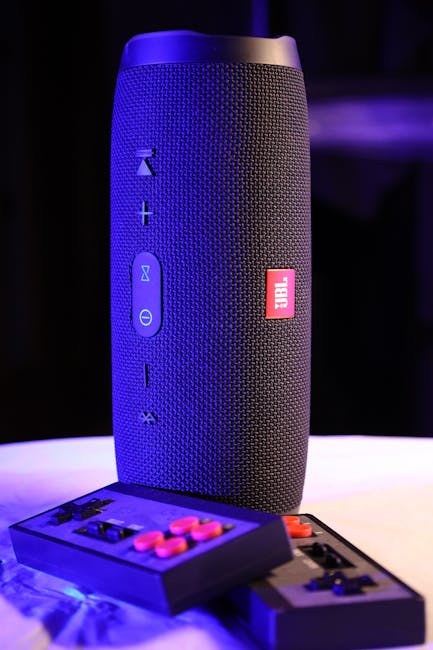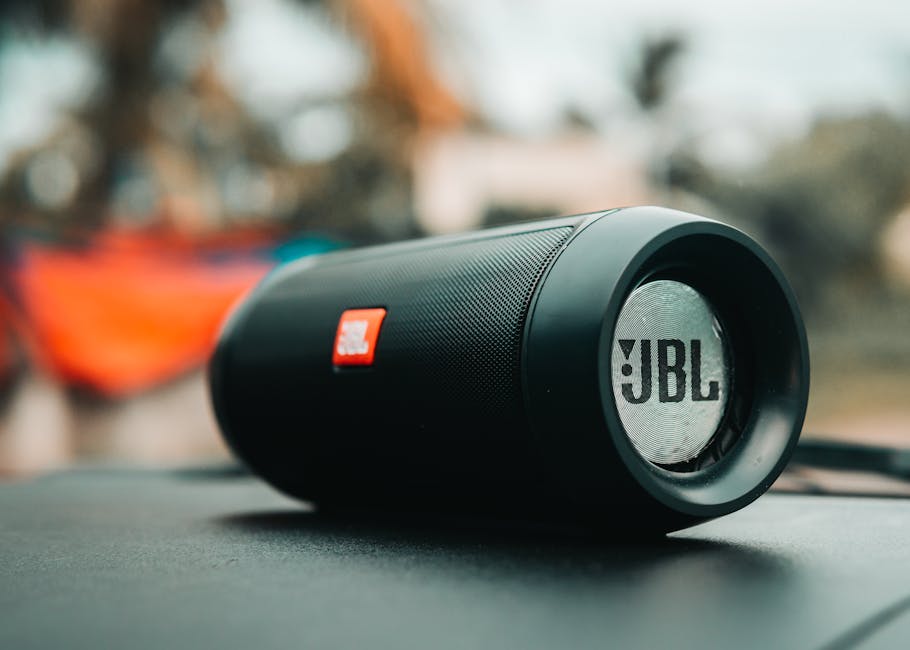Introduction to Linking JBL Speakers

Linking JBL speakers offers an exciting way to elevate your audio experience, whether you’re hosting a lively backyard party, setting up a home theater, or organizing a large event. By connecting multiple JBL speakers, you create a synchronized, immersive sound system that amplifies volume and enhances clarity across spaces. Imagine transforming your outdoor gathering with seamless, powerful sound that reaches every corner—linking speakers makes this possible. Users often choose to link JBL speakers to boost sound output, achieve stereo effects with distinct left and right channels, or enable multi-room audio for a cohesive listening experience throughout their home.
JBL provides three distinct connection technologies—PartyBoost, Connect+, and Auracast—each designed for specific speaker models and purposes. Compatibility is key, as these technologies are not interchangeable, and understanding their differences is crucial for a successful setup. According to JBL’s official claims, technologies like PartyBoost and Connect+ can link over 100 speakers, delivering a massive audio network for any occasion. This comprehensive guide will walk you through detailed steps for each technology, provide compatibility insights, address troubleshooting tips, and explore creative uses for your linked speakers. Whether you’re a tech novice or a seasoned audiophile, our actionable instructions cater to all JBL speaker types, ensuring you achieve the perfect sound setup with ease.
- Enhance Audio: Linking JBL speakers creates a powerful, synchronized sound system ideal for events or home use.
- Key Benefits: Amplify sound, enable stereo effects, and support multi-room audio.
- Technologies: PartyBoost, Connect+, and Auracast are JBL’s connection methods, with compatibility as a critical factor.
- Guide Overview: Covers step-by-step linking, compatibility, troubleshooting, and setup ideas.
Understanding JBL Speaker Connection Technologies

Before diving into the process of linking JBL speakers, it’s essential to understand the underlying connection technologies: PartyBoost, Connect+, and Auracast. Each technology dictates how your speakers interact, and knowing their differences is critical to avoid frustration during setup. These systems have evolved over time to meet varying user needs, from basic stereo pairing to expansive multi-speaker networks. A common pain point for users is discovering that these technologies are not cross-compatible—knowing which one your speaker supports is the first step to success. This section provides a foundational overview, setting the stage for detailed explorations of each method.
JBL’s connection technologies trace their roots back to Connect+, introduced around 2017, which marked a shift toward multi-speaker pairing capabilities. PartyBoost followed as an upgrade in newer models like the Flip 5, enhancing range and usability. Auracast represents the cutting edge, featured in the latest JBL releases as of recent years. Let’s break down each technology to clarify their unique features and applications, ensuring you can identify the right method for your devices.
- PartyBoost: Found in newer models (e.g., Flip 5, Charge 5), supports 100+ speaker connections with improved Bluetooth range and stereo/party mode options.
- Connect+: Used in models post-2017 (e.g., Flip 4, Charge 3), also connects up to 100+ speakers but with limitations in newer updates.
- Auracast: The latest technology for cutting-edge models, offering advanced features but not compatible with older systems.
PartyBoost Technology
PartyBoost is JBL’s modern connection technology, designed for newer models like the Flip 5 and Charge 5. It builds on previous systems by offering a robust Bluetooth range and the ability to link over 100 speakers for an expansive sound network. Whether you’re hosting a large outdoor event or creating a party atmosphere, PartyBoost provides flexibility with two distinct modes: Party Mode for uniform sound across all speakers, and Stereo Mode for a left-right channel split. This makes it ideal for diverse settings, from sprawling festivals to intimate home gatherings.
- Key Features: Connect 100+ speakers, enhanced Bluetooth range, Party and Stereo Mode options.
- Compatible Models: Includes JBL Flip 5, Flip 6, Charge 5, Pulse 4, Xtreme 3, and Boombox 2.
- Ideal Use Cases: Large events, outdoor parties, and dynamic home audio setups.
- Benefits: Seamless multi-speaker synchronization with intuitive controls via the JBL Portable app.
Connect+ Technology
Connect+ paved the way for multi-speaker pairing in JBL’s lineup, introduced around 2017 for models like the Flip 4 and Charge 3 (with firmware updates). It supports linking up to 100+ speakers, offering a powerful solution for expansive audio coverage. While it includes stereo pairing and party mode capabilities, some models, such as the Charge 3, lost stereo functionality after certain firmware updates, creating limitations for users. Despite being older than PartyBoost, Connect+ remains a reliable choice for compatible devices.
- Key Features: Links up to 100+ speakers, supports stereo pairing and party mode (where updates allow).
- Compatible Models: Includes JBL Flip 4, Charge 3 (with update), Pulse 3, Xtreme 2, and Boombox.
- Limitations: Some stereo pairing features may be unavailable post-firmware updates on certain models.
- Use Cases: Medium to large gatherings, home entertainment systems prior to PartyBoost models.
Auracast Technology
Auracast represents JBL’s latest leap in audio connection technology, integrated into the newest speaker models. Unlike PartyBoost and Connect+, Auracast focuses on cutting-edge features tailored to modern Bluetooth advancements, promising superior range and connectivity options. However, it is not compatible with older JBL technologies, which can be a hurdle for users with mixed speaker collections. As Auracast is still gaining traction, widespread adoption and detailed model lists are evolving, so users are encouraged to consult JBL’s official resources for the most current information.
- Latest Innovation: Designed for JBL’s newest releases with advanced connectivity features.
- Non-Compatibility: Does not work with PartyBoost or Connect+ speakers, limiting mixed setups.
- Evolving Support: Compatible models are expanding—check JBL’s official site for updates.
- Future Potential: Offers enhanced range and pairing options for next-gen audio experiences.
Step-by-Step Guide to Linking JBL Speakers
Linking PartyBoost-Compatible JBL Speakers
Preparation Steps
Before linking PartyBoost-compatible JBL speakers, a few preparation steps ensure a smooth process. Start by confirming that all your speakers support PartyBoost—refer to the model list or product manual if unsure. Power on each speaker and check their battery levels; a low battery can disrupt pairing, so charge them if necessary. Keep the speakers in close proximity (within a few feet) during the initial setup to avoid connection issues. Using the JBL Portable app, you can monitor battery status and ensure everything is ready for the next steps.
- Verify that all speakers support PartyBoost technology (e.g., Flip 5, Charge 5).
- Turn on each speaker by pressing the power button.
- Ensure sufficient battery levels—use the JBL Portable app for a quick check.
- Place speakers within a few feet of each other to facilitate pairing.
Pairing Process
With preparation complete, pairing PartyBoost speakers is straightforward. Download the JBL Portable app if you haven’t already—it’s a valuable tool for managing connections. Start by connecting the primary speaker to your device via Bluetooth through your phone’s settings. Then, press the PartyBoost button (marked with an ∞ symbol) on the primary speaker and subsequently on additional speakers to join the network. Listen for a confirmation sound or check the app for a visual cue indicating successful linking.
- Download and open the JBL Portable app on your smartphone.
- Connect the primary speaker to your device via Bluetooth in your phone settings.
- Press the PartyBoost button (∞ symbol) on the primary speaker.
- Repeat the button press on additional speakers to link them.
- Confirm connection via a sound cue or app notification—take a screenshot of settings for reference if needed.
Mode Selection (Party vs. Stereo)
Once your PartyBoost speakers are linked, you can customize the audio output using the JBL Portable app. Choose between Party Mode, which plays the same sound across all speakers for uniform coverage, ideal for large gatherings like a BBQ. Alternatively, select Stereo Mode for a left-right channel split, enhancing depth for home theater setups—place speakers about 10 feet apart for optimal effect. Experiment with placement to find the best sound balance for your space.
- Party Mode: Uniform audio across all speakers; great for events and wide coverage.
- Stereo Mode: Separates audio into left and right channels; perfect for immersive home listening.
- Placement Tip: For Stereo Mode, position speakers apart to maximize channel separation.
Linking Connect+-Compatible JBL Speakers
Preparation Steps
Preparing Connect+-compatible speakers mirrors the process for PartyBoost but includes a few unique considerations. Ensure all speakers support Connect+ by checking their model numbers (e.g., Flip 4, Charge 3 with update). Power on each device and verify battery levels to avoid interruptions. For older models like the Charge 3, confirm that firmware updates are installed to enable Connect+ functionality—refer to JBL’s support page for update guides if needed. Keep speakers close during setup for reliable pairing.
- Confirm Connect+ compatibility for all speakers (e.g., Flip 4, Pulse 3).
- Power on each speaker using the designated button.
- Check battery levels and charge if necessary to prevent disruptions.
- Ensure firmware is updated, especially for models like Charge 3, via JBL’s support resources.
Connection Process
Linking Connect+ speakers is user-friendly and follows a clear sequence. Begin by connecting the main speaker to your device via Bluetooth through your phone’s settings. Then, press the Connect+ button (marked with a + symbol) on the main speaker, followed by the same button on additional speakers to join the group. Wait for a confirmation tone indicating successful pairing. For added control, use the JBL Connect app to manage your setup and troubleshoot if needed.
- Connect the primary speaker to your device via Bluetooth in settings.
- Press the Connect+ button (+ symbol) on the primary speaker—note its distinct design.
- Press the same button on additional speakers to link them.
- Listen for a confirmation tone signaling successful connection.
- Optionally, use the JBL Connect app for enhanced management features.
Configuration Options
After connecting, configure your Connect+ speakers using the JBL Connect app to select between stereo pairing (left-right channel split) or multi-speaker party mode (uniform sound). Be aware that some models, like the Charge 3, may lose stereo pairing capabilities after firmware updates, so check your speaker’s status in the app. Adjust settings based on your environment, whether it’s a home setup or a larger event space, to achieve the desired audio effect.
- Stereo Pairing: Creates a left-right audio split for immersive sound (if supported post-update).
- Party Mode: Uniform sound across speakers for wider coverage.
- Update Caution: Models like Charge 3 may lose stereo features after updates—verify via app.
Linking Auracast-Compatible JBL Speakers
Required Steps
Linking Auracast-compatible speakers involves steps tailored to JBL’s latest technology. First, confirm that your speakers support Auracast by checking the product manual or JBL’s official site, as model lists are still expanding. Power on all speakers and ensure they’re charged to avoid interruptions. Follow the specific pairing instructions in your speaker’s manual or via the JBL Portable app for advanced options. Given Auracast’s newness, staying updated through JBL’s resources ensures you have the latest pairing details.
- Verify Auracast compatibility through the manual or JBL’s official website.
- Power on all speakers and ensure adequate battery levels.
- Follow manual-specific pairing steps or use the JBL Portable app for guidance.
- Keep speakers close during initial setup for a stable connection.
Compatibility Considerations for JBL Speakers
Compatibility Chart for JBL Technologies
Understanding compatibility between JBL’s connection technologies prevents setup mishaps. The chart below compares PartyBoost, Connect+, and Auracast, detailing which technologies work together and their standout features. Compatibility matters because mismatched technologies will not pair, a frequent source of user frustration. Use this as a quick reference to ensure your speakers can link before starting the process.
| Technology | Compatible With | Not Compatible With | Notable Features |
|---|---|---|---|
| PartyBoost | PartyBoost speakers | Connect+, Auracast | Greater Bluetooth range, 100+ speaker linking |
| Connect+ | Connect+ speakers | PartyBoost, Auracast | 100+ speaker linking, stereo limited by updates |
| Auracast | Auracast speakers | PartyBoost, Connect+ | Advanced connectivity, evolving support |
Model-Specific Compatibility Lists
Knowing which JBL models support specific technologies simplifies the linking process. Below are lists of models grouped by technology, based on current data. For Auracast, compatibility is still developing, so regularly check JBL’s official site for updates. Use these lists to confirm your speakers’ capabilities before attempting to pair them.
- PartyBoost Models: Flip 5, Flip 6, Charge 5, Pulse 4, Pulse 5, Xtreme 3, Boombox 2.
- Connect+ Models: Flip 4, Charge 3 (with update), Pulse 3, Xtreme 2, Boombox.
- Auracast Models: Compatibility evolving—refer to JBL’s official resources for the latest list.
Troubleshooting Common JBL Speaker Connection Issues
Speakers Won’t Connect
If your JBL speakers fail to connect, several common issues might be the cause. Identifying and resolving these can get your setup back on track quickly. Follow these solutions to address the most frequent problems encountered during linking.
- Incompatible Technology: Ensure all speakers use the same technology (e.g., all PartyBoost); refer to compatibility chart.
- Low Battery: Charge speakers fully before attempting to pair.
- Outdated Firmware: Update firmware via the JBL Portable or Connect app.
- Reset Solution: Perform a 30-second reset as per JBL manuals—hold power and volume buttons on most models.
Poor Audio Quality After Linking
Poor sound quality post-linking can detract from your listening experience, but it’s often fixable. Common causes include speaker placement or environmental interference. Use these tips to enhance audio output.
- Distance Issues: Keep speakers within recommended range—test at 10 ft vs. 30 ft to compare quality.
- Obstacles: Remove physical barriers (walls, furniture) between speakers.
- Interference: Avoid WiFi routers or microwaves disrupting Bluetooth signals.
- Firmware Fix: Ensure latest updates are installed for optimal performance.
Frequent Connection Drops
Connection drops can interrupt playback, often due to range or interference issues. Implementing these solutions helps maintain a stable link between your JBL speakers.
- Range Limitation: Stay within the recommended range for your technology (e.g., PartyBoost offers extended range).
- Interference Check: Minimize nearby Bluetooth or WiFi devices causing disruptions.
- Reset Connection: Disconnect and re-pair speakers if drops persist.
- Firmware Update: Download the latest firmware to address known connectivity bugs.
Advanced Features and Tips for Linked JBL Speakers
Maximizing the JBL Portable App
The JBL Portable app (or JBL Connect for older models) is a powerful tool for managing linked speakers. It answers user questions like “Can I customize sound?” or “How do I update firmware?” by offering a suite of features to enhance your experience. Download it from your app store to unlock full control over your audio setup.
- Firmware Updates: Keep speakers up-to-date to fix bugs and improve performance.
- EQ Settings: Customize bass, treble, and midrange for tailored sound.
- Mode Switching: Toggle between Party and Stereo Modes effortlessly.
- Battery Monitoring: Check levels in-app—take a screenshot for quick reference during events.
Creative Setup Ideas for Linked Speakers
Linked JBL speakers open up a world of creative audio setups for various environments. These ideas inspire unique listening experiences, addressing user curiosity about maximizing their system’s potential. Experiment with these configurations for memorable soundscapes.
- Multi-Room Audio: Place speakers in different rooms for cohesive home sound.
- Outdoor Event Coverage: Spread speakers across a venue for uniform party audio.
- Stereo Separation: Position two speakers 10 ft apart in a living room for a stereo effect.
- Surround Sound Simulation: Arrange multiple speakers around a space for a theater-like experience.
Supplemental Questions to Enhance Understanding
Key Questions About Linking JBL Speakers
Below are answers to common queries about linking JBL speakers, providing deeper insight without overloading the main guide. These address lingering doubts and reinforce key concepts for clarity.
- Can I link PartyBoost with Connect+ speakers? No, they are not compatible—each technology works only with its own type.
- What is Party Mode vs. Stereo Mode? Party Mode plays uniform sound across all speakers; Stereo Mode splits audio into left-right channels for depth.
- Which JBL models use PartyBoost? Key models include Flip 5, Flip 6, Charge 5, Pulse 4, Xtreme 3, and Boombox 2.
- How does Auracast compare to PartyBoost in range? Auracast offers potentially superior range as a newer tech, but specifics vary by model—check JBL’s site for updates.







